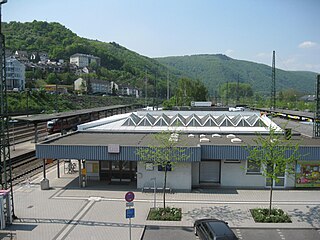
Bingen (Rhein) Hauptbahnhof is a railway station in the German city of Bingen am Rhein on the West Rhine Railway. It is located in the borough of Bingerbrück. The station that serves central Bingen is called Bingen Stadt.

The East Rhine Railway is a major, double-track, electrified railway line, running along the right bank of the Rhine from Cologne to Wiesbaden. The 179-kilometer (111.2 mi)-long line forms two Deutsche Bahn routes. Route 465 extends from Cologne to Koblenz, via Troisdorf, Bonn-Beuel, Unkel, and Neuwied. From Koblenz, Route 466 extends to Wiesbaden, via Rüdesheim am Rhein. Together with the Taunus railway, the line is used by Stadt-Express line SE-10 of the Rhine-Main Transport Association, which runs from Frankfurt to Koblenz and Neuwied.

The Taunus Railway is a double-track electrified railway line, which connects Frankfurt and Wiesbaden, Germany. It is 41.2 km long and follows the course of the Main on its north side, running quite close to it in some places. Its first stage was opened in September 1839 and is thus the oldest railway line in the German state of Hesse and one of the oldest in Germany. Today it is used by Regional-Express trains between Frankfurt and Wiesbaden and the trains of line S1 of the Rhine-Main S-Bahn between Frankfurt-Höchst and Wiesbaden. Between Frankfurt Hbf and Frankfurt-Höchst, they run on the line of the former Hessian Ludwig Railway.

The Ländches Railway (Ländchesbahn) is a single-track non-electrified branch railway line between Wiesbaden and Niedernhausen, in the German state of Hesse. The 19.6-kilometre (12.2 mi) long line was opened in 1879. It is now Deutsche Bahn route 627 and route 21 of the Rhein-Main-Verkehrsverbund.

Bonn-Beuel station is on the East Rhine Railway in the Bonn district of Beuel in the German state of North Rhine-Westphalia.
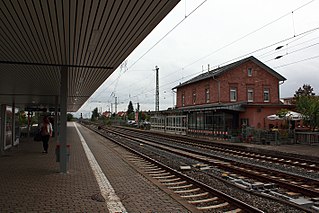
Kelsterbach station is the station of the town of Kelsterbach in the German state of Hesse on the Main Railway from Mainz to Frankfurt. The station is classified by Deutsche Bahn as a category 5 station.

Niedernhausen station serves the municipality of Niedernhausen in the German state of Hesse. It is the most important station on the Main-Lahn Railway between the stations of Frankfurt-Höchst and Eschhofen in Limburg an der Lahn. It is the terminus of the Ländches Railway running from Niedernhausen to Wiesbaden Hauptbahnhof and of line S2 of the Rhine-Main S-Bahn from Frankfurt.
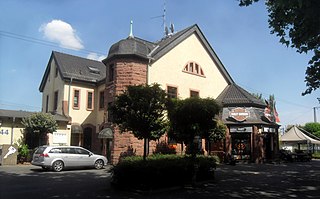
Wiesbaden Ost (east) station is situated on the Frankfurt–Wiesbaden line in the German state of Hesse. It was opened as part of the Taunus Railway, which was opened in 1839/40. The station was opened as part of the last stage of construction of the line to Wiesbaden and was opened on 19 May 1840.

Weinheim (Bergstraße) Hauptbahnhof is a station in the town of Weinheim in the German state of Baden-Württemberg. It is served by Intercity services on the Main-Neckar Railway between Frankfurt and Heidelberg/Mannheim. The Weschnitz Valley Railway (Weschnitztalbahn) to Furth in the Odenwald starts at Weinheim station. There is also a freight railway to Viernheim, the last remaining section of the former Weinheim–Worms railway.

Neu-Isenburg station is on the Rhine-Main S-Bahn in Neu-Isenburg in the German state of Hesse. It was opened on 1 November 1852 and is now served by S-Bahn and regional trains operated by Deutsche Bahn. Since 29 May 1961, it has been the only station in Hesse with a loading terminal for motorail trains. In addition, it has two bus stops, a taxi stand and a park and ride car park. The station is classified by Deutsche Bahn as a category 4 station.

Friedrichsdorf (Taunus) station is in the centre of Friedrichsdorf on Bahnstraße. Although the city has mostly dispensed with the appendage of "Taunus" in its name the station still officially retains it, although signs on the newest platform and Rhein-Main-Verkehrsverbund maps do not include it. The station is classified by Deutsche Bahn as a category 4 station.
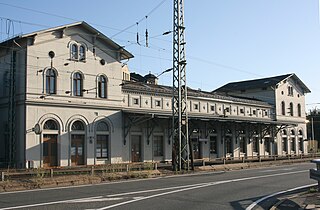
Rüdesheim (Rhein) station is in the town of Rüdesheim am Rhein in the German state of Hesse on the East Rhine Railway. It is on the western edge of the town, separated from the Rhine only by federal highway B 42. The entrance building is a double storey stucco building in a neoclassical style. It is now one of the cultural monuments listed in the UNESCO World Heritage Site of the Upper Middle Rhine Valley. The station is classified by Deutsche Bahn as a category 5 station.

Bingen (Rhein) Stadt station is, after Bingen Hauptbahnhof, the second largest station in the town of Bingen am Rhein in the German state of Rhineland-Palatinate. The station is located on the West Rhine Railway between Koblenz to Mainz. Furthermore, the station is the beginning and end of the Rheinhessen Railway to/from Worms. The station is classified by Deutsche Bahn as a category 4 station.

Groß Gerau station is located approximately 500 metres north of the centre of the town of Groß-Gerau in the German state of Hesse on the Rhine-Main Railway, running from Wiesbaden and Mainz to Darmstadt and Aschaffenburg. A curve branches off near the station connecting to the nearby Groß-Gerau-Dornberg station on the Mannheim–Frankfurt railway. The station is classified by Deutsche Bahn as a category 5 station. The station name has no hyphen unlike the town it is in, following a Prussian government order of 1910, which applied because of Prussian finance for the line, even though the station was in the Grand Duchy of Hesse.

Stadtallendorf station is a through station at the 82.1 km mark of the Main-Weser Railway in the town of Stadtallendorf in the German state of Hesse. The station is classified by Deutsche Bahn (DB) as a category 4 station. The platforms, underpass and the area around the station were modernised and redecorated in preparation for the Hessentag celebrations of 2010.

Niederlahnstein station is, along with Oberlahnstein and Friedrichssegen, one of three stations in the town of Lahnstein in the German state of Rhineland-Palatinate. It is a separation station on the East Rhine Railway and the Lahn Valley Railway and is located in the Niederlahnstein district and forms a public transport hub for the Rhine-Mosel-Lahn area.

Oberlahnstein station is, along with Niederlahnstein and Friedrichssegen, one of three stations in the town of Lahnstein in the German state of Rhineland-Palatinate. It is a through station with 3 platform tracks on the East Rhine Railway and is located in the Oberlahnstein district. The adjacent former freight depot is now a brownfield site.

Bad Vilbel station is located at the 183.6 kilometre mark of the Main-Weser Railway in the town of Bad Vilbel in the German state of Hesse. The Nidder Valley Railway branches from Bad Vilbel via Nidderau to Glauburg-Stockheim. It is classified by Deutsche Bahn as a category 3 station.

Eltville station is the railway station of Eltville in the Rheingau in the German state of Hesse, on the East Rhine Railway from Wiesbaden to Koblenz. It is classified by Deutsche Bahn as a category 5 station.
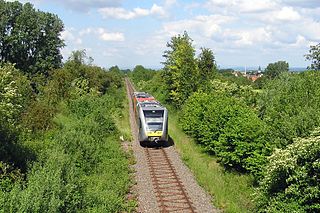
The Friedrichsdorf–Friedberg railway is a single-track, non-electrified branch line in the German state of Hesse. It is listed as timetable route 636 and integrated in the Rhein-Main-Verkehrsverbund as line 16.





















